Marcus Charles Beilby | |
|---|---|
| Born | 20 November 1951 [1] |
| Nationality | Australian |
| Alma mater | Claremont Technical College |
| Known for | Painting |
| Notable work | Crutching the Ewes, [2] Opening of Parliament House by Her Majesty Queen Elizabeth II on 9 May 1988 [3] |
| Style | Photorealism |
| Awards | 1987 Sir John Sulman Prize for Australian Genre Painting [4] |
| Website | marcusbeilby |
Marcus Charles Beilby (born 20 November 1951, in Western Australia), [1] is an Australian realist painter. [5] Beilby grew up in the Perth suburb of Mount Pleasant. He was educated at Applecross Senior High School and the Claremont Technical College, where he received a Diploma of Fine Arts (Painting) in 1975. [6]
Beilby was the winner of the 1987 Sir John Sulman Prize for Australian Genre Painting. [4] The winning painting, Crutching the ewes has been described as a homage to Tom Roberts' Shearing the Rams . [7]
In 1988, Charles Bush received a royal commission from Her Majesty Queen Elizabeth II to depict the inauguration of the permanent Parliament House. Sadly, Bush passed away the next year, leaving behind an initial sketch. As a result, Marcus Beilby was chosen to finalize the artwork and carry out the completion of the painting. [8]
He currently resides in East Fremantle, Western Australia. [9]
His father was the noted Australian author and novelist Richard Beilby. [10]
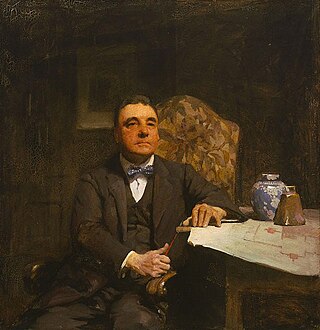
The Archibald Prize is an Australian portraiture art prize for painting, generally seen as the most prestigious portrait prize in Australia. It was first awarded in 1921 after the receipt of a bequest from J. F. Archibald, the editor of The Bulletin who died in 1919. It is administered by the trustees of the Art Gallery of New South Wales and awarded for "the best portrait, preferentially of some man or woman distinguished in Art, Letters, Science or Politics, painted by an artist resident in Australia during the twelve months preceding the date fixed by the trustees for sending in the pictures". The Archibald Prize has been awarded annually since 1921 and since July 2015 the prize has been AU$100,000.

Australian art is any art made in or about Australia, or by Australians overseas, from prehistoric times to the present. This includes Aboriginal, Colonial, Landscape, Atelier, early-twentieth-century painters, print makers, photographers, and sculptors influenced by European modernism, Contemporary art. The visual arts have a long history in Australia, with evidence of Aboriginal art dating back at least 30,000 years. Australia has produced many notable artists of both Western and Indigenous Australian schools, including the late-19th-century Heidelberg School plein air painters, the Antipodeans, the Central Australian Hermannsburg School watercolourists, the Western Desert Art Movement and coeval examples of well-known High modernism and Postmodern art.
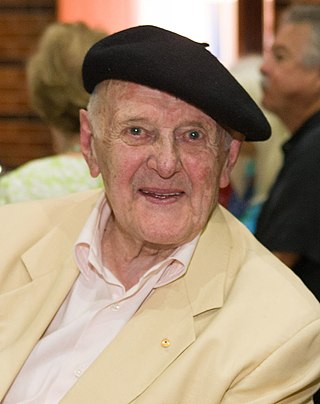
John Henry Olsen AO OBE was an Australian artist and winner of the 2005 Archibald Prize. Olsen's primary subject of work was landscape.
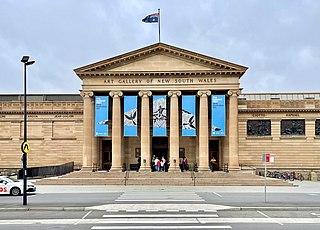
The Art Gallery of New South Wales (AGNSW), founded as the New South Wales Academy of Art in 1872 and known as the National Art Gallery of New South Wales between 1883 and 1958, is located in The Domain, Sydney, Australia. It is the most important public gallery in Sydney and one of the largest in Australia.
The Sir John Sulman Prize is one of Australia's longest-running art prizes, having been established in 1936.
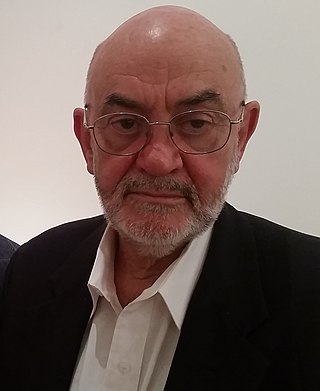
Rick Amor is an Australian artist and figurative painter. He was an Official War Artist for Australia.
Marcus Wills is an Australian painter, winner of the 2006 Archibald Prize and finalist in many other art competitions.
Robert Jacks was an Australian painter, sculptor and printmaker.

Shearing the Rams is an 1890 painting by Australian artist Tom Roberts. It depicts sheep shearers plying their trade in a timber shearing shed. Distinctly Australian in character, the painting is a celebration of pastoral life and work, especially "strong, masculine labour", and recognises the role that the wool industry played in the development of the country.

Vaughan Murray Griffin was an Australian print maker and painter.
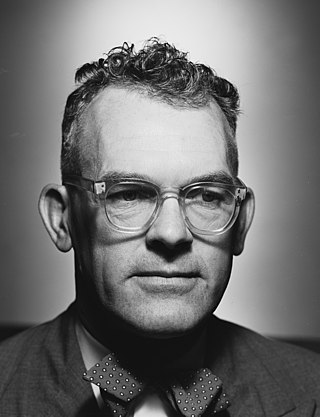
Harold "Hal" Missingham AO was an Australian artist, Director of the Art Gallery of New South Wales from 1945 to 1971, and president of the Australian Watercolour Institute from 1952 to 1955.
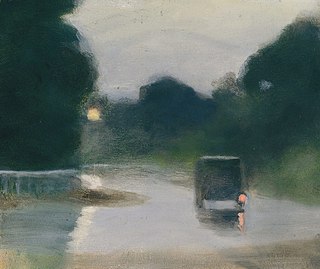
Australian tonalism was an art movement that emerged in Melbourne during the 1910s. Known at the time as tonal realism or Meldrumism, the movement was founded by artist and art teacher Max Meldrum, who developed a unique theory of painting, the "Scientific Order of Impressions". He argued that painting was a pure science of optical analysis, and believed that a painter should aim to create an exact illusion of spatial depth by carefully observing in nature tone and tonal relationships and spontaneously recording them in the order that they had been received by the eye.
Basil Hadley was an English Australian printmaker and painter. His works are represented in National and State public galleries around Australia and in various private collections.
Julie Dowling is an Indigenous Australian artist whose work, in a social realist style, deals with issues of Aboriginal identity. She identifies culturally and politically as a Badimaya First Nation woman.
Sally Robinson is an English-born Australian artist. She has had a long career as a portrait artist and designer, painter and printmaker, teacher and lecturer. Her work is represented in private and public collections around Australia.
Josephine Margaret Muntz Adams was an Australian artist who distinguished herself as a portraitist. Her portrait of Duncan Gillies, 14th Premier of the state of Victoria (1886-1890), hangs in Parliament House, Melbourne. Her portrait of the Queensland and Australian Federal politician Charles McDonald is in Parliament House, Canberra.
Annette Bezor, born Annette Bateman, was an Australian painter and feminist, who lived and worked in Adelaide, South Australia. She was known for appropriating classical and pop culture images of women and using them to create stylised representations of them, often sexually charged images but not pandering to the male gaze and thereby highlighting society's attitudes towards women. Her work won significant commercial and critical success.

Helen Elizabeth Ogilvie was a twentieth-century Australian artist and gallery director, cartoonist, painter, printmaker and craftworker, best known for her early linocuts and woodcuts, and her later oil paintings of vernacular colonial buildings.

Eleanor Constance "Nornie" Gude was an Australian artist.

Castlemaine Art Museum is an Australian art gallery and museum in Castlemaine, Victoria in the Shire of Mount Alexander. It was founded in 1913. It is housed in a 1931 Art Deco neo-classical building constructed for the purpose, heritage-listed by the National Trust. Its collection concentrates on Australian art and the museum houses historical artefacts and displays drawn from the district.